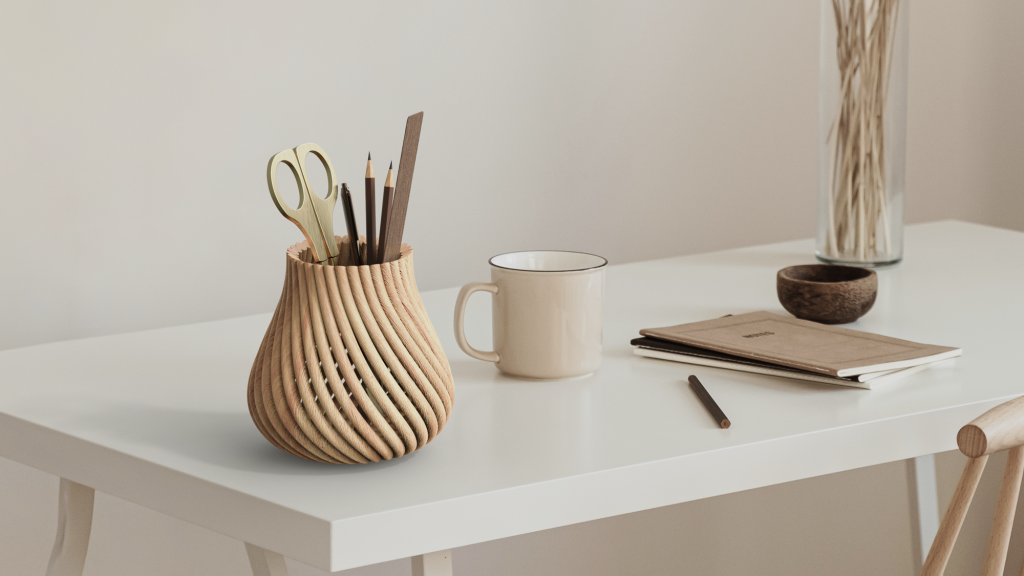Researchers at the耶路撒冷希伯来大学的have developed a novel wood-based 3D printing material that can morph into pre-designed shapes.
Made from a mixture of wood flour and plant extracts, the eco-friendly feedstock is able to shapeshift due to the fiber orientations in its wood content, which cause it to warp as it dries. While the team developed their material a few years ago, they recently discovered that by controlling the way it’s laid down, they could time how its moisture content evaporates, in a way that allows it to form complex objects.
Thus far, the scientists have 3D printed their wood-infused ink into saddle, dome and helix-shaped models, but with further development, they say it could be used to create more intricate self-assembling objects such as household furniture.
Wood’s unique morphing potential
In the natural world, it’s well known that certain species of plant and animal life can change shape, appearance or even texture. When it comes to wood, this capability comes from the orientations of its fibers, which cause it to shrink unevenly and warp, as seen in cut down trees. However, warpage may be viewed in 3D printing as a problem that needs dealing with, but the team are now approaching it differently.
“Warping can be an obstacle,” explains Doron Kam, a graduate student who recently unveiled the Hebrew University of Jerusalem’s material breakthrough at a meeting of the一个merican Chemical Society(ACS). “But we thought we could try to understand this phenomenon and harness it into a desirable morphing.”
While artificial structures don’t generally have the ability to change shape by themselves, scientists have increasingly investigated the potential of materials that can morph when triggered by thermal, pH or moisture stimuli. That said, the Israel-based team claims that research in this area is often limited to the 3D printing of flat sheets from gels and elastomers, which are synthetic by nature.

一个future 3D printing rival to IKEA?
In an attempt to harness wood’s natural shapeshifting capabilities, the researchers have now integrated it into a material composed of water as well as cellulose nanocrystals and xyloglucan, natural binders extracted from plants. Essentially, the team has found that the behavior of this feedstock can be precisely controlled by adjusting the speed and print path of the printhead used to deposit it.
Specifically, it was discovered that any shrinkage was perpendicular to the wooden fibers in the ink, and adjusting the speed of its deposition could change the way these fibers are aligned. As a result, accelerating the printing process enables the scientists’ material to warp in a predictable fashion, while depositing it slowly causes its wood content to become randomly oriented, and shrink in all directions.
During testing, it has already proven possible to stack two rectangular layers of the feedstock into a helix with different orientations, while adjusting its warpage to control the direction in which it spirals. One day, the team anticipate that their material could be used to 3D print furniture items such as chairs in a flat-packed fashion, which later turn into the products customers ordered upon opening.
In the near-term, theIsraeli Ministry of Science, Technology and Space-backed project is focusing on the potential of making the morphing process reversible. This work will see the researchers develop a means of getting their material to respond to environmental factors such as humidity, which could eventually be used to make it return to its original form.

一个dvancing wood’s 3D printing viability
While the Israeli team’s shapeshifting discovery is no doubt innovative, their efforts are the latest in a long line of attempts to develop a usable wood-based 3D printing material. In March 2021, it was also predicted that anMIT-developed lab-grown woodwould one day be deployed in the 3D printing of eco-friendly furniture.
Similarly, aneco-friendly wood 3D printing materialwhich emerged at theUniversity of Freiburga few months earlier, has shown potential for use within construction or light industrial applications. Composed of lignin mixed with cellulose balls, the team’s biosynthetic polymer is said to be compatible with both Direct Ink Writing (DIW) and Fused Deposition Modeling (FDM) 3D printers.
On the commercial front, meanwhile,Desktop Metal通过发射进入这个空间的呢Forust wood 3D printing brand. Using a material made from sawdust, lignin and a bio-epoxy resin, the firm now binder jet 3D prints decor and luxury architectural products that clientele can buy online. The company also markets the process as a service, for those seeking batch-made wooden parts.
To stay up to date with the latest 3D printing news, don’t forget to subscribe to the3D Printing Industry newsletteror follow us onTwitteror liking our page onFacebook.
While you’re here, why not subscribe to ourYoutubechannel? featuring discussion, debriefs, video shorts and webinar replays.
一个re you looking for a job in the additive manufacturing industry? Visit3D Printing Jobsfor a selection of roles in the industry.
Featured image shows one of the researchers’ helical prototypes. Photo via Doron Kam, the Hebrew University of Jerusalem.



